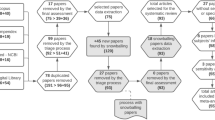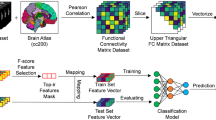Abstract
The advances in neuroimaging methods reveal that resting-state functional fMRI (rs-fMRI) connectivity measures can be potential diagnostic biomarkers for autism spectrum disorder (ASD). Recent data sharing projects help us replicating the robustness of these biomarkers in different acquisition conditions or preprocessing steps across larger numbers of individuals or sites. It is necessary to validate the previous results by using data from multiple sites by diminishing the site variations. We investigated partial least square regression (PLS), a domain adaptive method to adjust the effects of multicenter acquisition. A sparse Multivariate Pattern Analysis (MVVPA) framework in a leave one site out cross validation (LOSOCV) setting has been proposed to discriminate ASD from healthy controls using data from six sites in the Autism Brain Imaging Data Exchange (ABIDE). Classification features were obtained using 42 bilateral Brodmann areas without presupposing any prior hypothesis. Our results showed that using PLS, SVM showed poorer accuracies with highest accuracy achieved (62%) than without PLS but not significantly. The regions occurred in two or more informative connections are Dorsolateral Prefrontal Cortex, Somatosensory Association Cortex, Primary Auditory Cortex, Inferior Temporal Gyrus and Temporopolar area. These interrupted regions are involved in executive function, speech, visual perception, sense and language which are associated with ASD. Our findings may support early clinical diagnosis or risk determination by identifying neurobiological markers to distinguish between ASD and healthy controls.

Similar content being viewed by others
References
American Psychiatric Association (2013) Diagnostic and statistical manual of mental dis- orders, fourth edn., Washington, DC: American Psychiatric Association.
Anderson, J. S., Druzgal, T. J., Froehlich, A., Dubray, M. B., Lange, N., Alexander, A. L., Abildskov, T., Nielsen, J. A., Cariello, A. N., Cooperrider, J. R., et al. (2011a). Decreased interhemispheric functional connectivity in autism. Cereb Cortex, 21, 1134–1146.
Anderson, J. S., Nielsen, J. A., Froehlich, A. L., DuBray, M. B., Druzgal, T. J., Cariello, A. N., Cooperrider, J. R., Zielinski, B. A., Ravichandran, C., Fletcher, P. T., Alexander, A. L., Bigler, E. D., Lange, N., & Lainhart, J. E. (2011b). Functional connectivity magnetic resonance imaging classification of autism. Brain, 134(12), 3742–3754. https://doi.org/10.1093/brain/awr26322006979.
Benjamini Y, Hochberg Y. , (1995). Controlling the false discovery rate: a practical and powerful approach to multiple testing., J Roy Statist Soc Ser B (Methodological) 57:289-300.
Bertone, A., Mottron, L., Jelenic, P., & Faubert, J. (2005). Enhanced and diminished visuo-spatial information processing in autism depends on stimulus complexity. Brain, 128(Pt 10), 2430–2441.
Bhaumik, R., Jenkins, L. M., Gowins, J. R., Jacobs, R. H., Barba, A., Bhaumik, D. K., & Langenecker, S. A. (2016). Multivariate pattern analysis strategies in detection of remitted major depressive disorder using resting state functional connectivity. NeuroImage: Clinical. https://doi.org/10.1016/j.nicl.2016.02.018.
Castrillon, J. G., Ahmadi, A., Navab, N., & Richiardi, J. (2014). Learning with multi-site fmri graph data. In 2014 48th Asilomar conference on signals, systems and computers, IEEE (pp. 608–612).
Chen, C. P., Keown, C. L., Jahedi, A., Nair, A., Pflieger, M. E., Bailey, B. A., & Müller, R. (2015). Diagnostic classification of intrinsic functional connectivity highlights somatosensory, default mode, and visual regions in autism. NeuroImage: Clinical, 8, 238–245. https://doi.org/10.1016/j.nicl.2015.04.002.
Chen, H., Duan, X., Liu, F., Lu, F., Ma, X., Zhang, Y., Uddin, L. Q., & Chen, H. (2016). Multivariate classification of autism spectrum disorder using frequency-specific resting-state functional connectivity—A multi-center study. Progress in Neuro Psychopharmacology and Biological Psychiatry, 64, 1–9.
Cherkassky, V. L., Kana, R. K., Keller, T. A., & Just, M. A. (2006). Functional connectivity in a baseline resting-state network in autism. Neuroreport, 17, 1687–1690. https://doi.org/10.1097/01.wnr.0000239956.45448.4c.
Chevallier, C., Kohls, G., Troiani, V., Brodkin, E. S., & Schultz, R. T. (2012). The social motivation theory of autism. Trends in Cognitive Sciences, 16, 231–239.
Dakin, S., & Frith, U. (2005). Vagaries of visual perception in autism. Neuron, 48, 497–507.
Damiano, C. R., Aloi, J., Teadway, M., Bodfish, J. W., & Dichter, G. S. (2012). Adults with autism spectrum disorders exhibity decreased sensitivity to reward parameters when making effort-based decisions. Journal of Neurodevelopmental Disorders, 4, 13.
Di Martino, A., Yan, C. G., Li, Q., Denio, E., Castellanos, F. X., Alaerts, K., Anderson, J. S., Assaf, M., Bookheimer, S. Y., Dapretto, M., Deen, B., Delmonte, S., Dinstein, I., Ertl-Wagner, B., Fair, D. A., Gallagher, L., Kennedy, D. P., Keown, C. L., Keysers, C., Lainhart, J. E., Lord, C., Luna, B., Menon, V., Minshew, N. J., Monk, C. S., Mueller, S., Müller, R. A., Nebel, M. B., Nigg, J. T., O’Hearn, K., Pelphrey, K. A., Peltier, S. J., Rudie, J. D., Sunaert, S., Thioux, M., Tyszka, J. M., Uddin, L. Q., Verhoeven, J. S., Wenderoth, N., Wiggins, J. L., Mostofsky, S. H., & Milham, M. P. (2014). The autism brain imaging data exchange: towards a large- scale evaluation of the intrinsic brain architecture in autism. Molecular Psychiatry, 19(6), 659–667. https://doi.org/10.1038/mp.2013.7823774715.
DiMartino, A., Kelly, C., Grzadzinski, R., Zuo, X. N., Mennes, M., Mairena, M. A., et al. (2011). Aberrant striatal functional con- nectivity in children with autism. Biological Psychiatry, 69, 847–856. https://doi.org/10.1016/j.biopsych.2010.10.029.
Dinstein, I., Heeger, D. J., Lorenzi, L., Minshew, N. J., Malach, R., & Behrmann, M. (2012). Unreliable evoked responses in autism. Neuron, 75, 981–991.
Dubac, B. (2014). The brain from top to bottom. McGill, 2002. Web.
Ecker, C., Marquand, A., Mourao-Miranda, J., Johnston, P., Daly, E. M., Brammer, M. J., et al. (2010). Describing the brain in autism in five dimensions—Magnetic resonance imaging-assisted diagnosis of autism spectrum disorder using a multi parameter classification approach. The Journal of Neuroscience, 30, 10612–10623. https://doi.org/10.1523/JNEUROSCI.5413-09.2010.
Fair D. A., Bathula D., Nikolas M. A., Nigg J. T., (2012) Distinct neuropsychological subgroups in typically developing youth inform heterogeneity in children with ADHD. Proceedings of the National Academy of Sciences 109 (17):6769-6774
Gotts, S. J., Simmons, W. K., Milbury, L. A., Wallace, G. L., Cox, R. W., & Martin, A. (2012). Fractionation of social brain circuits in autism spectrum disor- ders. Brain, 135, 2711–2725. https://doi.org/10.1093/brain/aws160.
Greicius, M. D., Krasnow, B., Reiss, A. L., & Menon, V. (2003). Functional connectivity in the resting brain: A network analysis of the default mode hypothesis. Proceedings of the National Academy of Sciences of the United States of America, 100, 253–258.
Hastie, T., Tibshirani, R., & Friedman, J. (2001). New York: Springer-Verlag.
Jiang, J. (2008). A literature survey on domain adaptation of statistical classifiers. Technical report, Computer Science Department at University of Illinois at Urbana-Champaign. Available at URL <http://sifaka.cs.uiuc.edu/jiang4/domainadaptation/survey>.
Keehn, B., Shih, P., Brenner, L. A., Townsend, J., & Muller, R. A. (2013). Functional connectivity for an “island of sparing” in autism spectrum disorder: An fMRI study of visual search. Human Brain Mapping, 34, 2524–2537. https://doi.org/10.1002/hbm.22084.
Lin, A., Tsai, K., Rangel, A., & Adolphs, R. (2012). Reduced social preferences in autism: Evidence from charitable donations. Journal of Neurodevelopmental Disorders, 4, 8.
Lombardo, M. V., Barnes, J. L., Wheelwright, S. J., & Baron-Cohen, S. (2007). Self-referential cognition and empathy in autism. PLoS ONE, 2, e883.
Lynch, C. J., Uddin, L. Q., Supekar, K., Khouzam, A., Phillips, J., & Menon, V. (2013). Default mode network in childhood autism: Pos- teromedial cortex heterogeneity and relationship with social deficits. Biological Psychiatry, 74, 212–219. https://doi.org/10.1016/j.biopsych.2012.12.013.
Minshew, N. J., & Goldstein, G. (1993). Is autism an amnesic disorder? Evidence from the California verbal learning test. Neuropsychology, 7, 209–216.
Müller, R.-A., Shih, P., Keehn, B., Deyoe, J. R., Leyden, K. M., & Shukla, D. K. (2011). Underconnected, but how? A survey of functional connectivity MRI studies in autism spectrum disorders. Cerebral Cortex, 21(10), 2233–2243. https://doi.org/10.1093/cercor/bhq29621378114.
Nair, A., Keown, C. L., Datko, M., Shih, P., Keehn, B., & Müller, R. A. (2014). Impact of methodolog- ical variables on functional connectivity findings in autism spectrum disorders. Human Brain Mapping, 35(8), 4035–4048. https://doi.org/10.1002/hbm.2245624452854.
Nielsen, J. A., Zielinski, B. A., Fletcher, P. T., Alexander, A. L., Lange, N., Bigler, E. D., Lainhart, J. E., & Anderson, J. S. (2013). Multisite functional connectivity MRI classification of au- tism: ABIDE results. Frontiers in Human Neuroscience, 7, 599. https://doi.org/10.3389/fnhum.2013.0059924093016.
Ozonoff, S., Pennington, B., & Rogers, S. (1991). Executive function deficits in high-functioning autistic individuals: Relationship to theory-of-mind. Journal of Child Psychology and Psychiatry, 32, 1081–1105.
Pan, S. J., & Yang, Q. (2010). A survey on transfer learning. IEEE Transactions on Knowledge and Data Engineering, 22(10), 1345–1359. https://doi.org/10.1109/TKDE.2009.191.
Perry, W., Minassian, A., Lopez, B., Maron, L., & Lincoln, A. (2007). Sensorimotor gating deficits in adults with autism. Biological Psychiatry, 61, 482–486.
Plitt, M., Barnes, K. A., & Martin, A. (2015). Functional connectivity classification of autism identifies highly predictive brain features but falls short of biomarker standards. NeuroImage: Clinical, 7, 359–366. https://doi.org/10.1016/j.nicl.2014.12.013.
Power J. D., Mitra A., Laumann T. O., Snyder A. Z., Schlaggar B. L., Petersen S. E., (2014) Methods to detect, characterize, and remove motion artifact in resting state fMRI. NeuroImage 84:320–341
Raichle, M. E., MacLeod, A. M., Snyder, A. Z., Powers, W. J., Gusnard, D. A., & Shulman, G. L. (2001). A default mode of brain function. Proc Natl Acad Sci U S A, 98, 676–682.
Rogers, S., & Pennington, B. (1991). A theoretical approach to the deficits in infantile autism. Dev Psychopathol, 3, 137–162.
Tibshirani, R. (1996). Regression shrinkage and selection via the lasso. Journal of the Royal Statistical Society. Series B (methodological), 58(1). Wiley: 267-88.
Tommerdahl, M., Tannan, V., Holden, J. K., & Baranek, G. T. (2008). Absence of stimulus-driven synchronization effects on sensory perception in autism: Evidence for local underconnectivity? Behavioral and Brain Functions, 4, 19.
Tyszka, J. M., Kennedy, D. P., Paul, L. K., & Adolphs, R. (2013). Largely typical patterns of resting-state functional connectivity in high- functioning adults with autism. Cerebral Cortex https://doi.org/10.1093/cercor/bht040.
Uddin, L. Q. (2011). The self in autism: An emerging view from neuroimaging. Neurocase, 17, 201–208.
Uddin L. Q., Menon V., Young C. B., Ryali S., Chen T., Khouzam A., Minshew N. J., Hardan A. Y., (2011). Multivariate searchlight classification of structural magnetic resonance imaging in children and adolescents with autism. Biological Psychiatry, 70(9): 833-841.
Uddin, L.Q., Supekar, K., Lynch, C.J., Khouzam, A., Phillips, J., Feinstein, C., Ryali, S., & Menon, V. (2013). Salience network-based classification and prediction of symptom severity in children with autism. J.A.M.A. Psychiatry 70, 869–879. 10.1001/ jamapsychiatry.2013.10423803651.
Van Dijk, K. R., Hedden, T., Venkataraman, A., Evans, K. C., Lazar, S. W., & Buckner, R. L. (2010). Intrinsic functional connectivity as a tool for human connectomics: Theory, proper- ties, and optimization. Journal of Neurophysiology, 103(1), 297–321. https://doi.org/10.1152/jn.00783.200919889849.
Vapnik, V. (1995). The natures of statistical learning theory. New York: Springer-Verlag.
Von dem Hagen, E. A., Stoyanova, R. S., Baron-Cohen, S., & Calder, A. J. (2013). Reduced func- tional connectivity within and between ‘social’ resting state networks in autism spec- trum conditions. Social Cognitive and Affective Neuroscience, 8, 694–701. https://doi.org/10.1093/scan/nss05322563003.
Wiggins, J. L., Peltier, S. J., Ashinoff, S., Weng, S. J., Carrasco, M., Welsh, R. C., et al. (2011). Using a self-organizing map algorithm to detect age-related changes in functional connectivity during rest in autism spectrum disorders. Brain Res, 1380, 187–197. https://doi.org/10.1016/j.brainres.2010.10.102.
Zhou, Y., Shi, L., Cui, X., Wang, S., & Lou, X. (2016). *Functional connectivity of the caudal anterior cingulate cortex is decreased in autism. PLoS One, 11(3), e0151879.
Zou, H., & Hastie, T. (2005). Regularization and variable selection via the elastic net. Journal of the Royal Statistical Society, Series B, 67, 301–320.
Acknowledgments
The authors wish to acknowledge Dr. Heide Klumpp, Assistant Professor of Psychiatry at University of Illinois at Chicago and Dr. Cameron Craddock from Child Mind Institute in New York for their valuable comments and suggestions.
Author information
Authors and Affiliations
Corresponding author
Electronic supplementary material
ESM 1
(DOCX 22 kb)
Rights and permissions
About this article
Cite this article
Bhaumik, R., Pradhan, A., Das, S. et al. Predicting Autism Spectrum Disorder Using Domain-Adaptive Cross-Site Evaluation. Neuroinform 16, 197–205 (2018). https://doi.org/10.1007/s12021-018-9366-0
Published:
Issue Date:
DOI: https://doi.org/10.1007/s12021-018-9366-0




